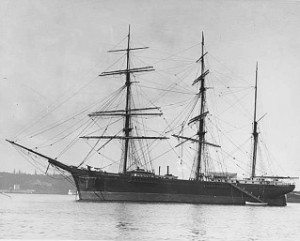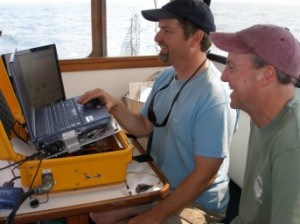Divers discover long-lost wreck
Research, hard work pays off as divers find the wreck of the long-lost bark Trajan, sunk outside Newport Harbor in 1867
NEWPORT — To the untrained eye, the scene that greeted John Stanford and Mark Munro 30 feet beneath Newport Harbor Saturday, Dec. 6, wouldn’t have looked like much: A massive pile of concretion and timbers covered in algae, seaweed, barnacles and anemones that rose up eight feet off the bottom and faded off into the murky distance. But for the two hardcore wreck divers and maritime historians, the modest scene was pay dirt: They’d found the long-lost Trajan, a 125-foot bark loaded with lime that sank August 17, 1867. The Trajan, one of thousands of ships that have gone down in Rhode Island waters since the days of the colonists, had been all but forgotten in the 141 years since she was lost. The men’s discovery that chilly December morning was the culmination of years of research, hard work and more than a bit of luck.”As soon as we hit the bottom I knew we’d found it,” said Mr. Munro, an amateur shipwreck hunter who works as a technician at a nuclear power plant in Connecticut. “Ultimately, it’s a mystery until you find it and when you close the page on that mystery, it’s just a good feeling.” “It was a thrill, to see it all the way through from nothing to actually seeing her on the bottom,” added Mr. Stanford, a Jamestown resident who’d heard stories of the Trajan for years and had always hoped to find her.
The Trajan

The divers’ discovery of the Trajan revives an important, but often overlooked, part of Rhode Island maritime history. While searches for Revolutionary-era frigates dominate much of the discussion around Narragansett Bay wrecks, the Trajan has more in common with the thousands of other wrecks that dot Rhode Island waters than her more famous counterparts. Named for the Roman emperor Trajan, she measured 125 feet in length, was nearly 30 feet in the beam and drew 13 feet of water. Built in 1856 in the H. Merrian yard in Rockland, Maine, she was one of many vessels that transported freight up and down the East Coast, Cuba, New Orleans and beyond in the days when maritime freight played a key role in Rhode Island’s economy and that of much of New England. At the time of her loss, the Trajan was carrying barrels of lime from Rockland to New Orleans. Lime, used extensively in plaster and mortar, is a dangerous cargo. Get it wet, and a chemical reaction could ignite the mineral and spark fire. Water won’t put it out, and so in the days of the Trajan lime captains’ only hope of saving their vessel was to snuff the flames by closing the hatches and killing the oxygen supply. That’s exactly what happened as Trajan‘s cargo began to smolder one stormy day off Newport in 1867. According to an account written in 1871 by Newport writer Thomas Higginson, author of the local history “Oldport Days,” the crew steered the Trajan from off Newport into Newport Harbor after noticing the fire, and fought a valiant but ultimately fruitless battle to save her: “I never saw anything seem so extinguished out of the universe as that great vessel, which had towered so colossal above my little boat; it was impossible to imagine that she was all there yet, beneath the foaming and indifferent waves. “In the coming years, the vessel’s hulk would be dynamited, partially salvaged and, ultimately, forgotten. Then John Stanford showed up.
Long lore

Mr. Stanford, an accountant for General Dynamics, spends most of his free time aboard his 28-foot Nauset Adventurer, searching for and diving on the hundreds of known wrecks that dot Rhode Island and Massachusetts waters. He grew up in Rhode Island, bought his first boat as a teenager, and over the years has compiled an impressive diving resume. He’s visited the sunken German submarine U-853 off Block Island, found and recorded shipwrecks modest and proud off Martha’s Vineyard, and has visited Truk Lagoon, a southern Pacific lagoon where dozens of Japanese war vessels were sunk by the United States during World War II. Over the years, Mr. Stanford has compiled a formidable knowledge of Rhode Island wrecks, and the Trajan has long been one of them. Mr. Stanford first heard of her in the early 1980s, when he stumbled across an old chart listing the location of wrecks in and around Newport. A small spot on the chart showed a wreck just west of Goat Island, and through research Mr. Stanford eventually determined it was likely the resting spot of the Trajan. Further research showed that though others had searched for her, she had never been found or, more likely, found but never identified. For years, he and several diving friends searched for the wreck using rudimentary tools — mostly just a depth finder and long hours diving in locations they thought were the ship’s resting place. The result? Nothing. But even those many failures brought their own successes. Though he and his friends, Al Langner and David Knibbs, didn’t find the Trajan, they found other anomalies in the area, including a stone ballast pile which they believe could have been the remains of one of several ships scuttled by the British when the French sailed into Newport in 1778.”It was always something that we were looking for, but we never could find it,” said Mr. Stanford. “But I always remembered it and thought, ‘I’d love to find it.’ “The search took a crucial turn in the late 1990s, when Mr. Stanford found several old newspaper clippings that alluded to the wreck and the fact that its submerged hull may have fouled the keel of a deep draft pleasure yacht in 1901.”Could this have been the Trajan? The evidence sure pointed that way,” he said. He packed the knowledge away and decided to start the search anew one day.
High-tech search

Last fall, Mr. Stanford contacted his friend Mark Munro with a proposition to search for the wreck. Like Mr. Stanford, Mr. Munro is a member of Sound Underwater Survey, a loose confederation of friends who live for finding and exploring old wrecks. He’s also a techie, and owns sophisticated magnetometer and side scan sonar equipment. Magnetometers work by finding ferrous metals, such as iron, on the bottom, and side scan sonar takes “pictures” of the bottom by bouncing sound waves off the ocean floor and processing the sound of the returning echoes. Mr. Stanford’s idea was to use Adventurer as a platform for Mr. Munro’s equipment. “I said ‘Sure, let’s look,'” said Mr. Munro. Armed with an approximate search area, the two set out in September to look for the wreck. It didn’t take long to record a target, but at first neither could say for sure whether it was the Trajan. “We found something, but it could have been anything; there weren’t the usual straight lines you’d expect to see on a wreck,” said Mr. Munro. Looking at the data back at home in Connecticut, though, he became more and more convinced that they’d found the Trajan. “Once I overlaid the magnetometer (results) on the sonar image, and the age of the shipwreck, we decided we probably had it.” There was only way to say for sure.
Discovery at last

On Saturday, Dec. 6, the two donned drysuits and trailered Mr. Stanford’s 13-foot inflatable to the Fort Adams boat ramp. After a 10-minute trip out to the site, they dropped anchor, put on their dive gear and followed the anchor line down to the bottom. Mr. Stanford went first.” I knew right away we’d found it,” Mr. Stanford recalls. “The wreck is mostly lime concretion 114 feet long by 55 feet wide, which is what you would expect knowing what we know about her. There were timbers coming up. It’s a pretty big field. “Lobster pot lines hung off the pile, and where it met the muddy harbor floor, heavy ship timbers jutted out of the sand. Blocks of solidified lime that still retained the shape of the oak barrels that once held them littered the site, and the few fish around were all but oblivious to the visitors dressed in dry suits to ward off the water’s 45-degree chill. The initial survey in September had yielded a strong magnetometer reading, and off one end of the wreck the pair found a small kedge anchor, about five feet long, that Mr. Stanford believes is probably one of the Trajan‘s auxiliary anchors. “Just seeing the lime was enough to confirm our suspicions of what it was,” she said. “I was psyched. I was like, ‘Hey, after all these years we finally found her. Mission accomplished.'”
What now?

enter the water on a dive.
In keeping with Rhode Island law, the pair didn’t take anything from the wreck, and don’t plan to. Instead, they videotaped their dive, took measurements of the debris field and now hope to share their information with others devoted to preserving Rhode Island’s maritime heritage, including the Rhode Island Marine Archaeology Project (RIMAP) and the Rhode Island Historical Preservation and Heritage Commission. “That’s really what this search was about,” said Mr. Stanford. “It’s just another puzzle in Newport’s seafaring past. We learned a lot about the lime trade, the local seafaring trade, and that’s enough.” “It’s a fascinating history, and this is one small part. Every piece gives you a better picture of what things were like, and we’re happy to add to that.”
Learn more
For more on the discovery of the bark Trajan, including side scan sonar images, magnetometer readings, an underwater video of the wreck site shot in December, and historical accounts of the vessel’s loss, see www.soundunderwatersurvey.com/wrecks/trajan
